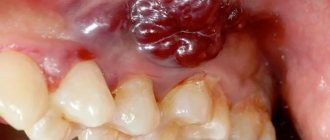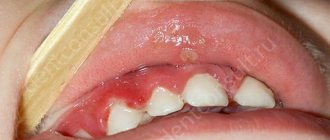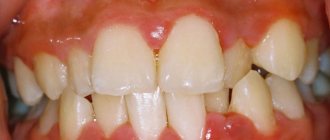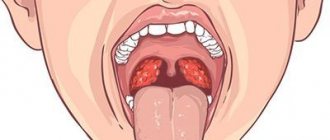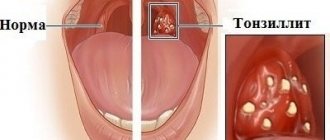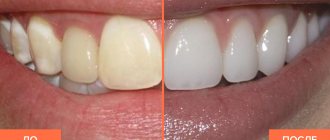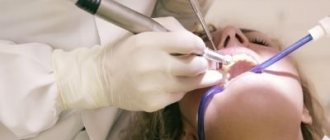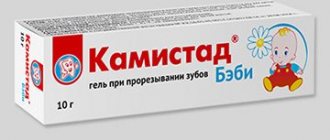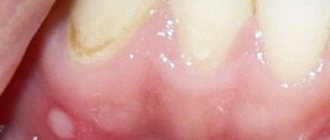Bumps in the mouth: what they are, their causes and treatment
Any neoplasms in the oral cavity require careful study of the clinical picture. This can be either a harmless growth or an alarming signal from the body. Thus, a lump on the roof of the mouth often occurs as a result of a cold or infection. This formation does not cause discomfort and resolves on its own after strengthening the immune system. If the growth is accompanied by pain and other unpleasant symptoms, this may indicate a serious pathology. Only a doctor can determine the cause of the lump and tell you what to do.
Factors contributing to the formation of bubbles:
- Oral diseases: caries, pulpitis, periodontitis, stomatitis;
- Unbalanced diet;
- Allergy to toothpaste or mouthwash;
- Injuries;
- Poor hygiene;
- Hereditary predisposition;
- Hormonal imbalance;
- Immunity impairment;
- Alcohol and nicotine addiction.
Watery blisters on the mucous membrane in some cases can indicate the occurrence of serious diseases. Such manifestations occur with tuberculosis, syphilis or diabetes. Therefore, if such a pathology occurs, it is recommended to immediately make an appointment with a doctor and undergo the necessary examination. The first sign is the sensation of a strange object in the mouth that is in the way.
Why do bumps appear in the sky?
A growth in the mouth appears as a result of blockage of blood vessels and stagnation of organic fluids, which causes inflammation in the mucosal tissues. Among the most common causes of pathology are the following:
- bad habits – alcohol abuse and smoking;
- chronic diseases – sore throat, sinusitis;
- constant exposure to traumatic factors - incorrectly fitted crowns that become infected, eating too hot food, sucking on lollipops, etc.;
- insufficient oral hygiene - food remains behind the teeth become a favorable environment for the development of pathogenic microflora;
- inflammation of the salivary glands;
- colds and infectious diseases;
- Doctor’s mistakes – incorrect filling or tooth extraction.
A child can also develop a lump in the mouth. In most cases, the pathology occurs due to bruises, which are quite common in childhood.
Bumps also form in the mouth due to cancer (leukoplakia and papillomatosis), which pose a great danger to human health and life.
Treatment
Usually a bloody blister does not require specific treatment. Since it is a natural response of the immune system to external stimuli, the formation goes away on its own within a few days.
Important! If the resulting blister did not appear due to injury, often recurs, or multiple growths are noted, a doctor’s consultation is required to rule out possible pathologies.
In some cases, therapy for hematoma is indicated. It is required for large bladder size, pain and discomfort. When treating, the dentist takes into account the following factors:
- size of education;
- time and factor of appearance;
- location of the bubble: on the cheek, tongue, lip, gums;
- whether there are other blisters or sores.
If the bubble does not go away, contact your dentist.
Treatment of a bloody ball consists of a puncture, ensuring the outflow of accumulated fluid and antiseptic treatment. Rarely, surgical excision of tissue is required to remove the lesion.
When blisters appear due to chipped teeth or incorrect dental work, the defects must be corrected. Otherwise, the cheek will be constantly injured.
Important! If the doctor suspects that the bubbles have formed not due to injuries, but as a consequence of systemic pathologies, the patient will be prescribed a comprehensive examination. Further therapy will be based on test results.
According to indications, multivitamin complexes with a high content of vitamins C, K, E, A, and group B can be prescribed. This will strengthen the walls of blood vessels and prevent hemorrhages.
After surgery, the patient is recommended to:
- stop smoking and drinking alcohol for a while;
- do not eat food that irritates the mucous membranes: salty, smoked, spicy, pickled, rough;
- treat the oral cavity with medicinal solutions and herbal infusions with an antiseptic and wound-healing effect: chlorhexidine, miraministin, soda-saline solution, decoctions of chamomile, oak bark, sage.
To be safe from complications, rinse your mouth with an antiseptic solution for several days.
What can and cannot be done if a blister appears on the cheek?
The formation of a blood globule is always a cause for concern. However, there is no need to panic. First of all, it is necessary to establish the reason why it could appear: whether there were injuries, whether hot or irritating food was consumed. Further actions are aimed at relieving inflammation and disinfection:
- The mouth is treated with antiseptic drugs.
- Rinsing with a solution of baking soda and salt will help relieve inflammation.
- Provoking factors are excluded: smoking, alcohol, consumption of salty, sour, spicy, pickled foods.
If after a few days the ball does not shrink and signs of healing are not visible, you should consult a doctor: dentist or therapist.
It is strictly forbidden to pierce the formation yourself. This can lead to infection or even greater injury.
Bloody blisters in the mouth most often appear as a result of injuries: biting, burns, chemical injuries. Less common factors are diseases of the oral cavity and systemic pathologies. As a rule, no special treatment is required. If the formation interferes, the dentist pierces it and prescribes antiseptic treatment.
General symptoms
A tumor formed in the oral cavity can be of different colors: white, dark red, blue, transparent yellow. Sometimes it is soft, in other cases it is dense. A lump that appears against the background of one pathology may differ depending on the individual characteristics of the patient’s body: age, general condition of his body, bad habits, etc.
The lump appears in the form of a bubble, growth, ball, compaction, tumor with faint edges. Spots (change in color of the mucous membrane) may also form in the affected area. In some cases, numbness is felt in a certain part of the oral cavity, difficulties appear when swallowing, and the voice changes. In advanced forms of the disease, the cones may be damaged, which provokes bleeding with an unpleasant taste and odor.
Painful lumps indicate inflammation and suppuration. General health worsens, body temperature may rise. Purulent intoxication of the body occurs. In this case, the lump grows, it becomes hard and hot, and the regional lymph nodes enlarge.
Features of appearance and diagnosis of neoplasms
In order to determine the true cause of the elevation of the mucous membrane in the mouth, it is necessary to look at it from the outside in daylight, although often at first glance all the changes in the mucous membranes are very similar, but there are still differences.
The bubble occurs with scarlet fever, food allergies or when using low-quality toothpaste.
Types of skin changes that may occur on the surface of the oral cavity:
- A spot is a change in skin color that does not rise above the surface of the skin. The cause may be a banal allergic reaction.
- A papule is a small spherical formation on the mucous membrane that is completely filled with fluid. It often has a transparent color and is accompanied by a slight inflammatory process around it. The cause of this change may be an injection or scratch from mucous food.
- A tubercle - in appearance it is very similar to a papule or vesicle, but does not contain liquid inside. Unsuccessful biting of the cheek between the teeth can provoke prolonged healing of the wound, which will lead to the formation of a tubercle.
- A node is a dense formation that does not contain fluid and rises very much above the surface of the skin. On palpation, the node is clearly palpable and often has a spherical shape. This picture occurs with pathology of the salivary glands. It is worth contacting an oral and maxillofacial surgeon.
- A blister is a superficial formation, upon examination of which one can see the accumulation of fluid under the top layer of the skin. In the case of the oral cavity under non-keratinizing epithelium. This pathology occurs after a burn from hot food or air.
- A vesicle is a papule that has a capsule of liquid on its surface. More often, this liquid is clear or white.
- An ulcer is a round wound that has a depression inside and rough edges. Can be of various sizes. The cause of an ulcer can be a lot of local and general diseases, so if an ulcer does not heal for a long time, you should consult a dentist or surgeon.
Each of the formations has its own reason for its appearance, which greatly influences further treatment.
Diagnosis of diseases accompanied by the formation of lumps in the mouth
Tumors have appeared in the mouth, and the question is, which doctor should I contact? This symptom is a prerequisite for visiting the dentist. To diagnose the disease, the doctor will first conduct a visual examination and palpation, and collect an anamnesis. A puncture is taken from the resulting lump and a bacteriological examination is carried out, which makes it possible to determine the cause of its occurrence.
Based on the results obtained, the doctor determines the need to use other diagnostic methods:
- general tests;
- X-ray;
- Ultrasound;
- biopsy.
If the cause of the formation of a lump on the upper palate is beyond the scope of the dentist’s competence, the patient is prescribed consultations with other specialists (pediatrician, therapist, gastroenterologist, endocrinologist, hepatologist). Only after making a diagnosis will the doctor determine how to treat the disease.
Dental diseases
At an advanced stage of periodontitis, a fistula forms near the tooth involved in the painful process. If periostitis (inflammation of the periosteum) develops, flux may appear. At first the lump is hard, but over time it becomes softer and filled with pus.
In case of periodontitis, the tooth is unfilled and the root canals are cleaned. After removing the exudate, oral baths are prescribed using special solutions. In case of periostitis, the dentist opens the tooth, places medications in the cavity, and closes it with a temporary filling. If this treatment does not help, the tooth is removed.
How to recognize herpes
The difficulty is that the symptoms of herpes in the mouth are easily confused with the manifestation of stomatitis and other diseases of the oral mucosa.
Differences:
- as a rule, stomatitis affects a larger area of the oral mucosa compared to herpes;
- swelling with herpes is less: with stomatitis, there may even be traces of teeth on the mucous membrane of the cheeks;
- ulcers that form during stomatitis have more defined boundaries;
- stomatitis often contributes to the appearance of a very dense coating on the tongue; with herpes, such a symptom does not appear;
- very often with stomatitis (especially purulent, with ulcers), the pain is more intense, it intensifies when the disease spreads over a large area of the mucous membrane. The pain is aching, especially in ulcers, and it becomes difficult to eat food, especially hard and hot food.
Photo of herpes on the gum:
If measures are not taken in time, a viral infection can become complicated and take the form of herpetic stomatitis:
How to understand that the virus has been activated? The first symptoms are tingling on the gums, itching and burning sensation. Then the color of the oral mucosa may change, unpleasant swelling appears locally, then a bright red rash appears, and the last stage is the formation of characteristic “bubbles” with liquid. As the disease progresses, the pain intensifies. When bubbles appear (they are called vesicles), the pain becomes cutting, its intensity increases when eating food or hot drinks.
Vesicles are dropsy filled with fluid with a high concentration of virus. Their sizes increase over time and can reach from 1 mm to 1 cm in diameter. At some point they burst, leaving a painful wound. If an infectious infection occurs, the wound becomes covered with a yellow crust, the mucous membrane of the oral cavity is increasingly affected, flowing into diffuse stomatitis.
External symptoms may include:
- increase in body temperature up to 38 degrees;
- chills;
- increase in size of lymph nodes;
- weakness, loss of strength;
- headache.
Such symptoms more often appear in children, with severe disease and the presence of an inflammatory process. In this case, you cannot do without consulting a doctor.
As a rule, the clinical picture of the disease is obvious. If a relapse does not occur for the first time, often the blisters are localized in the same areas: on the inner surface of the cheeks, tongue, gums. Your doctor may prescribe an oral swab to rule out a fungal or bacterial infection.
There are several types of herpes. As a rule, virus strains 1 and 2 appear on the gums. The consequences can be serious, especially if action is not taken promptly. If it was possible to extinguish the external manifestations of the infection, this is not a reason to refuse further treatment. First of all, you need to determine what type of herpes the patient is dealing with: PCR diagnostics will help with this. If you have a herpes infection, you can contact specialists such as an ENT specialist, an infectious disease specialist, or an immunologist. They will help you choose a treatment regimen that will minimize relapses of the disease in the future.
Angioma
It is a benign formation, which in most cases is a congenital pathology in children. It consists of blood vessels and is dark red in color. Sometimes it looks like a small ball on a leg. Lymphangioma, formed from lymphatic vessels, most often appears on the soft palate. It looks like a small bump with a bubbly surface. First, the tumor grows inside, then a swelling appears that hurts.
The choice of treatment method depends on the type of vessels. The angioma is removed or reduced by sclerotherapy, alcohol injection, or radiation therapy. If there is a risk of severe swelling, the formation is excised with a scalpel. The ball-shaped angioma is removed using a galvanoacoustic loop.
Preventive measures
To reduce the risk of developing pathologies in the oral cavity, you should follow a number of recommendations:
- quit smoking and alcohol;
- normalize nutrition - do not eat hot, salty and spicy foods, introduce fermented milk and plant products into the diet;
- carefully and regularly observe oral hygiene;
- start treatment of any pathologies in a timely manner;
- Take vitamin complexes periodically (after consultation with your doctor).
If you experience the slightest discomfort in the palate, you should see a dentist. Paying attention to your health prevents the development of complications.
